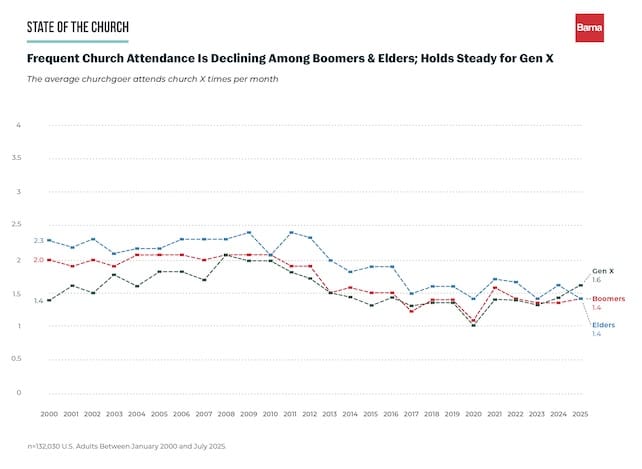A Generational Reversal
The rebound of churchgoing among younger adults contrasts with older generations, whose participation is flat (as shown in the next chart). Over the last 25 years, Elders and Boomers are well below the frequency of attendance they practiced in the past; Gen X churchgoing has landed at about the same rate as it was in 2000.

Looking back, Elder churchgoers came about 2.3 times per month in 2000 and Boomers were consistently attending about half of all weekends (2.0 times per month). Those participation rates have steadily declined over the past 25 years. Gen X attendance has held steady but has not grown. In contrast, younger generations have moved from an average of just over one weekend per month in 2020 to nearly two in 2025.
Also noteworthy is that all three older generations of churchgoers are about as likely to attend church as in the years immediately before the pandemic.
Turning Churchgoers Into Disciples
“The significant drop-off among older generations shows that the fabric of congregational life is changing. It’s more frayed and less gray than it was a decade ago,” notes David Kinnaman, CEO of Barna Group. “The influx of new generations represents a massive opportunity for congregational leaders, but this renewed interest must be stewarded well.”
“Our research clearly shows that churchgoing alone does not in itself create devoted disciples. Even with the increasing participation of younger generations, there is still the challenge of shaping hearts and minds to live out their faith beyond church participation,” adds Kinnaman.
RELATED: Carey Nieuwhof on the ‘Many Implications’ AI Has for Churches That Pastors Must Not Ignore
What This Means for Church Leaders
For pastors and ministry leaders, the uptick in next gen church attendance presents both opportunity and challenge:
- Opportunity: Younger adults are coming back. Churches that offer relational connection, spiritual mentoring and authentic belonging can nurture this renewed interest into depth of faith.
- Challenge: Attendance, while improving, is still far from weekly. Discipleship strategies must account for a rhythm where people are present at church less than half the time. Digital tools can help bridge this gap. Church apps for texting and small groups, as well as online resources for spiritual growth can help augment the in-person Sunday experience.
Looking Ahead
If these trends continue, the spiritual explorations of the next generation could redefine the makeup and momentum of Christianity and of congregations in the coming decade. The data points to a future where the vitality of the Church may hinge on how well leaders engage the spiritual curiosity and commitments of younger adults.
About the Research
Barna Group’s tracking data is based on online and telephone interviews within nationwide random samples of 132,030 adults conducted over a twenty-five-year period ending in July 2025. These studies are conducted utilizing quota sampling for representation of all U.S. adults by age, gender, race / ethnicity, region, education and income. Minimal statistical weighting has been used when necessary to maximize statistical representativeness. Included in this data is 5,580 online interviews that were collected between January and July of 2025. These interviews were also conducted utilizing quota sampling for age, gender, race / ethnicity, region, education and income, and minimal statistical weighting has been used to maximize statistical representation.

